2009 AUDI S4 CABRIOLET belt
[x] Cancel search: beltPage 96 of 340
![AUDI S4 CABRIOLET 2009 Owners Manual Seats and storage
[ i] Tips
Some of the controls are fitted on certain model s only or they are
opt ional equipment. •
Applies to vehic les: w ith man ually adjustab le sea ts AUDI S4 CABRIOLET 2009 Owners Manual Seats and storage
[ i] Tips
Some of the controls are fitted on certain model s only or they are
opt ional equipment. •
Applies to vehic les: w ith man ually adjustab le sea ts](/manual-img/6/57654/w960_57654-95.png)
Seats and storage
[ i] Tips
Some of the controls are fitted on certain model s only or they are
opt ional equipment. •
Applies to vehic les: w ith man ually adjustab le sea ts
Adjusting the manual seats
Position, angle and shape of the manual seats can be
adjusted to provide safe and comfortable seating.
Reed and heed all WARNINGS ~ & before you adjust your
seat.
Moving the seat forward or backward
Lift lever G) ~ page 93, fig. 104 and slide the seat to the
desired position.
- Release the lever
(D and then move the seat further until
you feel and hear it engage .
Extending/shortening the seat cushion*
-Grab the handle just below the front edge of the seat®
~ page 93 , fig. 104.
- Slide the seat cushion extens ion backward or forward to
the desired position. Release the handle to lock the
extension in place.
Adjusting the seat cushion angle
- Pull the lever 0 ~ page 93, fig. 104 up and pump it to
raise the front of the seat cushion.
- Push the lever
0 down and pump it to lower the front of
the seat cushion. -
In either case, shift your weight in the direction you want
the seat to tilt to support the adjustment action.
Adjusting the seat height
- Pull the lever © up and pump it to raise the seat .
- Push the lever © down and pump it to lower the seat.
Adjusting the lumbar support
-Press the corresponding depression on the switch shell
© to adjust the height and contour of the lumbar
support, see~ page 98.
Adjusting the seatback angle
- Lean forward to take your weight off the seatback.
- Turn the hand wheel © in the direction you want the
seatback to ti It.
& WARNING
• Never adjust the driver or front passenger seat while the
vehicle is moving. If you do this while the vehicle is moving, you
will be out of position. Always adjust the driver's or front
passenger seat when the vehicle is not moving.
• Be careful when adjusting the seat height. Check to see that no
one is in the way, or serious injury could result!
• To reduce the risk of injury in the case of sudden braking or
accident, front passengers must never ride in a moving vehicle
with the seatback reclined. Safety belts and the airbag system
only offer maximum protection when the seatback is upright and
the safety belts are properly positioned on the body. The more the
seatback is reclined, the greater the risk of personal injury from an
incorrect seating position and improperly positioned safety
belts! •
Page 97 of 340
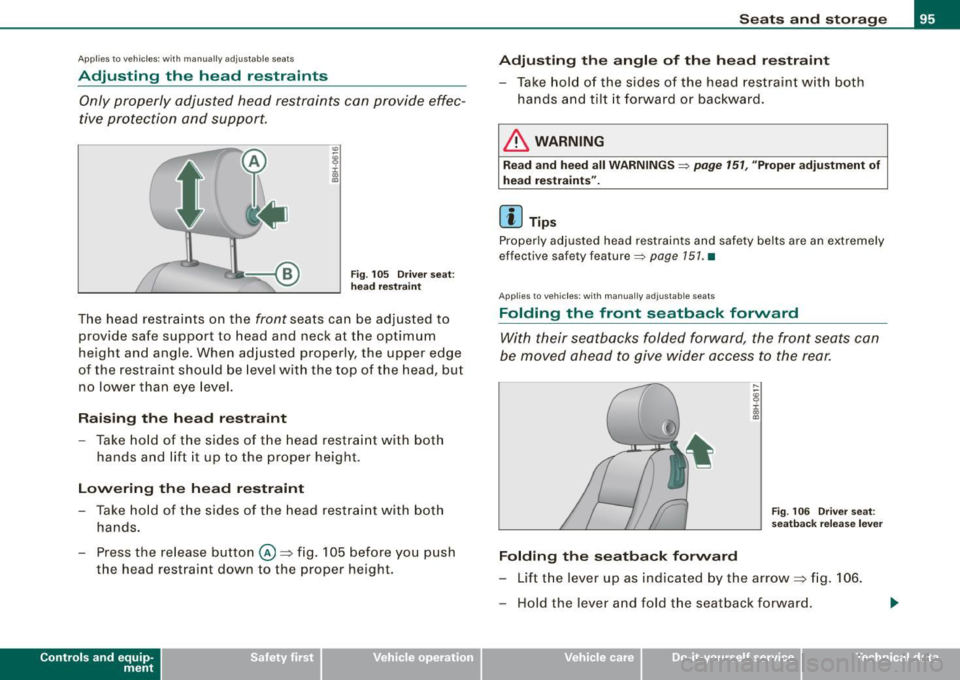
Applies to vehic les: with manua lly adjustab le seats
Adjusting the head restraints
Only properly adjusted head restraints can provide effec
tive protection and support.
Fig . 105 Driver seat:
head restraint
The head restraints on the front seats can be adjusted to
provide safe support to head and neck at the optimum
height and angle . When adjusted properly, the upper edge
of the restraint should be level with the top of the head, but
no lower than eye level.
Raising the head restraint
-Take hold of the sides of the head restraint with both
hands and lift it up to the proper height.
Lowering the head restraint
- Take hold of the sides of the head restraint with both
hands.
- Press the release button @=>fig. 105 before you push
the head restraint down to the proper height.
Controls and eq uip
ment
Seats and storage
Adjusting the angle of the head restraint
- Take hold of the sides of the head restraint with both
hands and tilt it forward or backward.
& WARNING
Read and heed all WARNINGS => page 151, "Proper adjustment of
head restraints".
[ i] Tips
Properly adjusted head restraints and safety belts are an extremely
effective safety feature=>
page 151. •
App lies to veh ic le s: with manua lly adjustab le sea ts
Folding the front seatback forward
With their seatbacks folded forward, the front seats can
be moved ahead to give wider access to the rear.
Folding the seatback forward
Fig . 106 Driver seat:
seatback release lever
-Lift the lever up as indicated by the arrow => fig. 106.
- Hold the lever and fold the seatback forward.
~ehicle care irechnical data
Page 99 of 340
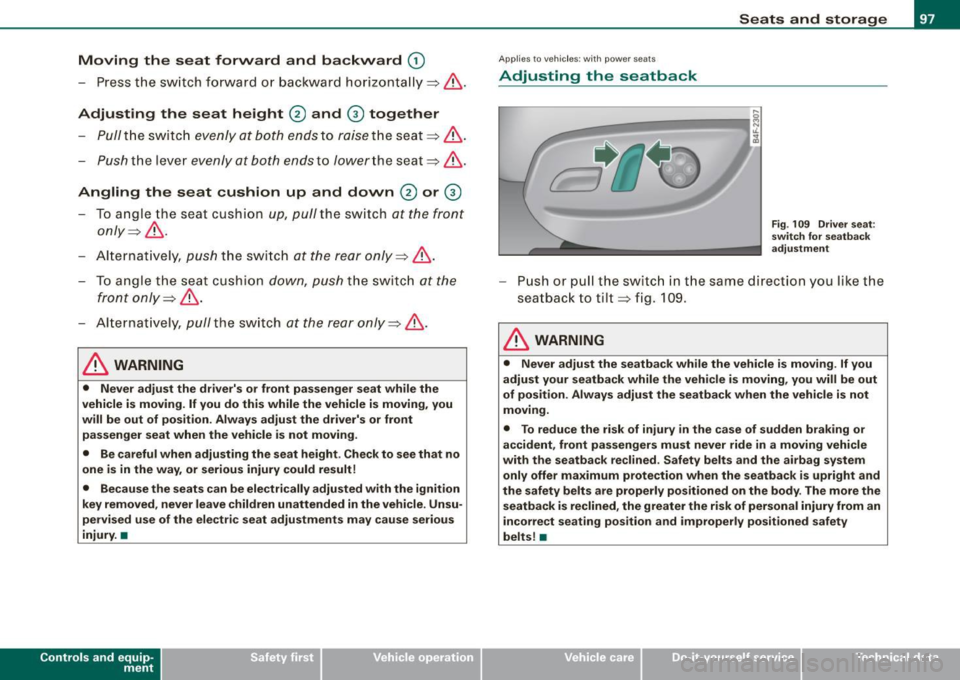
Moving the seat forward and backward (D
-Press t he swi tch fo rward or back ward h orizon ta lly => & -
Adjusting the seat height @ and 0 together
Pull the sw it c h eve nly at b oth ends to r aise th e sea t=> & .
-Pus h th e le ver e venl y at both ends to lo we r the seat =>& .
Angling the seat cushion up and down @ or 0
To an gle th e se at cush ion up, pull th e swit ch at t he front
on ly=>
&-
- Alter nativel y, push the sw it c h at the re ar onl y=> & .
- To ang le the seat cush io n down, pu sh the switch at th e
fron t o nly =>
&-
- Alt e rn ativ ely, p ull the switch at the r ea r only =>& .
& WARNING
• Never adjust the driver's or front passenger seat while the
vehicle is moving . If you do this while the vehicle is moving , you
will be out of position . Always adjust the driver's or front
passenger seat when the vehicle is not moving.
• Be careful when adjusting the seat height . Check to see that no
one is in the way, or serious injury could result!
• Because the seats can be electrically adjusted with the ignition
key removed , never leave children unattended in the vehicle. Unsu
pervised use of the electric seat adjustments may cause serious
injury. •
Contro ls and eq uip
ment
Ap plies to veh ic les : w ith powe r seats
Adjusting the seatback
Seats and storage
Fig . 109 Driver seat :
sw itch for seatback
adjustment
Push or pull th e swit ch in th e sa me dir ectio n y ou lik e the
s eat back t o tilt => fig. 1 09.
& WARNING
• Never adjust the seatback while the vehicle is moving . If you
adjust your seatback while the vehicle is moving, you will be out
of position . Always adjust the seatback when the vehicle is not
moving.
• To reduce the risk of injury in the case of sudden braking or
accident, front passengers must never ride in a moving vehicle
with the seatback reclined . Safety belts and the airbag system
only offer maximum protection when the seatback is upright and
the safety belts are properly positioned on the body . The more the
seatback is reclined , the greater the risk of personal injury from an
incorrect seating position and improperly positioned safety
belts !•
~ehicle care irechnical data
Page 105 of 340
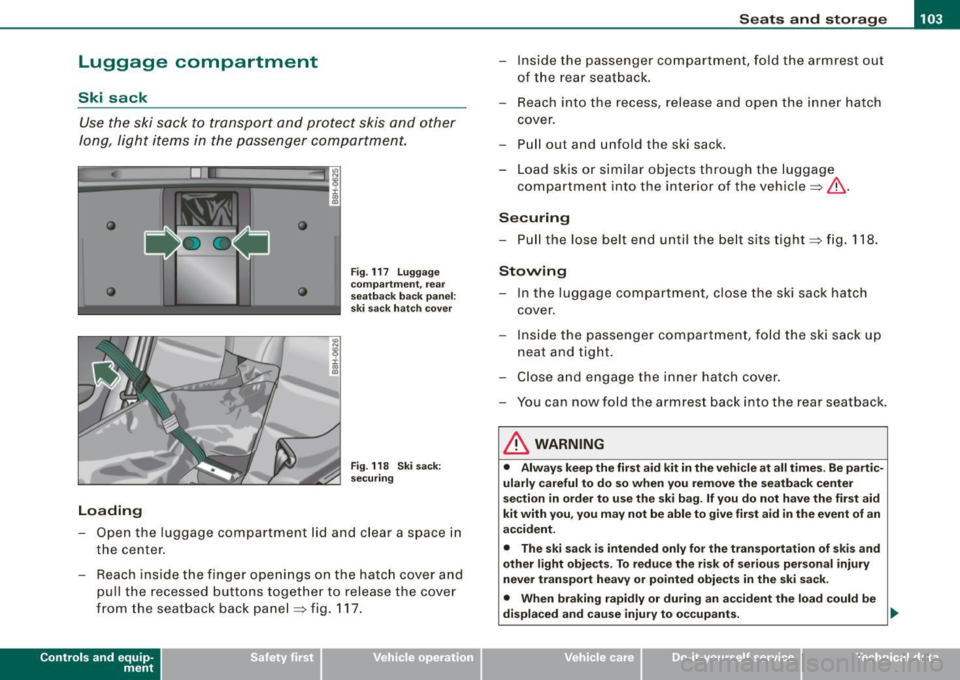
__________________________________________________ S_ e_ a_t _s _ a_n _ d_ s_ t _ o_ r_a ...;:g ::.. e _ ___,_
Luggage compartment
Ski sack
Use the ski sack to transport and protect skis and other
long , light items in the passenger compartment.
Loading
Fig . 117 Luggage
compartment, rear
seatback back panel:
ski sack hatch cover
Fig . 118 Ski sack:
securing
- Open the luggage compartment lid and clear a space in
the center.
- Reach ins ide the finger openings on the hatch cover and
pull the recessed buttons together to release the cover
from the seatback back panel :::;, fig. 117.
Contro ls and eq uip
ment
- Inside the passenger compartment, fold the armrest out
of the rear seatback.
- Reach into the recess, release and open the inner hatch
cover.
- Pull out and unfold the ski sack .
- Load skis or similar objects through the luggage
compartment into the interior of the vehicle :::;,,& .
Securing
-Pull the lose belt end until the belt sits tight :::;, fig. 118.
Stowing
- In the luggage compartment, close the ski sack hatch
cover .
- Inside the passenger compartment, fold the ski sack up
neat and tight.
- Close and engage the inner hatch cover.
- You can now fold the armrest back into the rear seat back.
& WARNING
• Always keep the first aid kit in the vehicle at all times . Be partic
ularly careful to do so when you remove the seatback center
section in order to use the ski bag. If you do not have the first aid
kit with you, you may not be able to give first aid in the event of an
accident.
• The ski sack is intended only for the transportation of skis and
other light objects . To reduce the risk of serious personal injury
never transport heavy or pointed objects in the ski sack.
• When braking rapidly or during an accident the load could be
displaced and cause injury to occupants. .,
~ehicle care irechnical data
Page 106 of 340
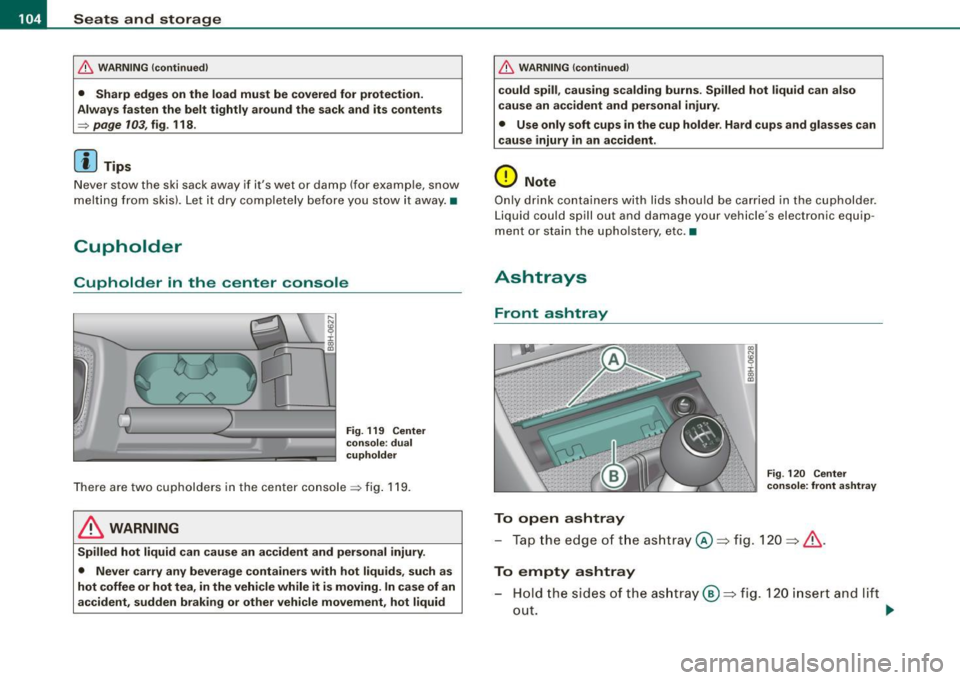
• .___S_ e_a _ t_ s_ a_ n_ d_ s_t _o _r_ a...; g==- e ________________________________________________ _
& WARNING (continued)
• Sharp edges on the load must be covered for protection.
Always fasten the belt tightly around the sack and its contents
~ page 103, fig. 118 .
[ i ] Tips
Never stow the ski sack away if it's wet or damp (for example, snow
melting from skis). Let it dry completely before you stow it away. •
Cupholder
Cupholder in the center consol e
Fig. 119 Center
console : dual
cupholder
There are two cupholders in the center console~ fig. 119 .
& WARNING
Spilled hot liquid can cause an accident and personal injury.
• Never carry any beverage containers with hot liquids, such as
hot coffee or hot tea, in the vehicle while it is moving. In case of an
accident, sudden braking or other vehicle movement, hot liquid
& WARNING (continued)
could spill, causing scalding burns. Spilled hot liquid can also
cause an accident and personal injury.
• Use only soft cups in the cup holder . Hard cups and glasses can
cause injury in an accident.
0 Note
Only drink containers with lids should be carried in the cupholder.
Liquid could spill out and damage your vehicle 's electronic equip
ment or stain the upholstery , etc. •
Ashtrays
Front ashtray
To open ashtray
Fig. 120 Center
console: front ashtray
-Tap the edge of the ashtray@::::, fig . 120 ::::, &.
To empty ashtray
Hold the sides of the ashtray@::::, fig. 120 insert and lift
out.
~
Page 148 of 340
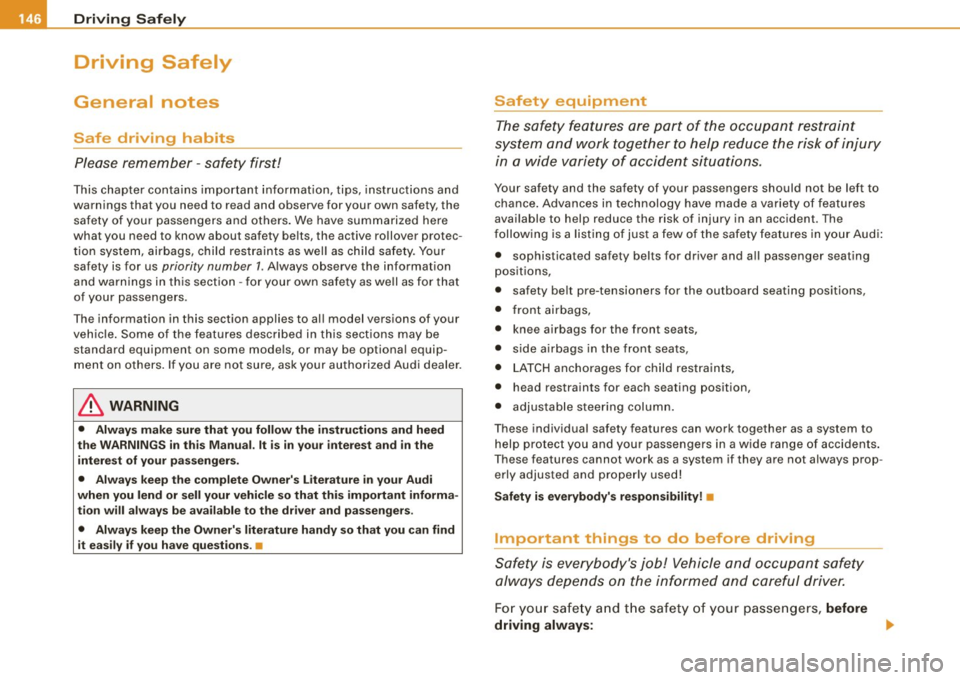
___ D_ ri_v _i_n ..;;:g::;,._ S_ a_ f _e__, ly'-- -------------------------------------------------
Driving Safely
General notes
Safe driving habits
Please remember -safety first!
This chapter contains important information, tips, instructions and
warnings that you need to read and observe for your own safety, the
safety of your passengers and others. We have summarized here
what you need to know about safety belts, the active rollover protec
tion system, airbags, child restraints as well as child safety. Your
safety is for us priority number 1 . Always observe the information
and warnings in this section -for your own safety as well as for that
of your passengers .
The information in this section applies to all model versions of your
vehicle. Some of the features described in this sections may be
standard equipment on some models, or may be optional equip
ment on others. If you are not sure, ask your authorized Audi dealer.
& WARNING
• Always make sure that you follow the instructions and heed
the WARNINGS in this Manual. It is in your interest and in the
interest of your passengers.
• Always keep the complete Owner's Literature in your Audi
when you lend or sell your vehicle so that this important informa
tion will always be available to the driver and passengers.
• Always keep the Owner's literature handy so that you can find
it easily if you have questions .•
Safety equipment
The safety features are part of the occupant restraint
system and work together to help reduce the risk of injury
in a wide variety of accident situations.
Your safety and the safety of your passengers should not be left to
chance. Advances in technology have made a variety of features
available to help reduce the risk of injury in an accident. The
following is a listing of just a few of the safety features in your Audi:
• sophisticated safety belts for driver and all passenger seating
positions,
• safety belt pre-tensioners for the outboard seating positions,
• front airbags,
• knee airbags for the front seats,
• side airbags in the front seats,
• LATCH anchorages for child restraints,
• head restraints for each seating position,
• adjustable steering column.
These individual safety features can work together as a system to
help protect you and your passengers in a wide range of accidents.
These features cannot work as a system if they are not always prop erly adjusted and properly used!
Safety is everybody's responsibility! •
Important things to do before driving
Safety is everybody's job! Vehicle and occupant safety
always depends on the informed and careful driver.
For your safety and the safety of your passengers, before
driving always: ..,
Page 149 of 340

________________________________________________ D_r_iv _ i _n...: g=--- S_ a_ fe--= ly'---------"'
- Make sure that all lights and signals are operating
correctly.
- Make sure that the tire pressure is correct.
- Make sure that all windows are clean and afford good
visibility to the outside.
- Secure all luggage and other items carefully~
page 107.
-Make sure that nothing can interfere with the pedals.
- Adjust front seat, head restraint and mirrors correctly for
your height.
- Instruct passengers to adjust the head restraints
according to their height.
- Make sure to use the right child restraint correctly to
protect children~
page 190, "Child Safety".
- Sit properly in your seat and make sure that your passen
gers do the same
~ page 92, "General recommenda
t ions" .
- Fasten your safety belt and wear it properly. Also instruct
your passengers to fasten their safety belts properly
~ page 159. •
What impairs driving safety?
Safe driving is directly related to the condition of the
vehicle, the driver as well as the driver's ability to concen
trate on the road without being distracted.
The driver is responsible for the safety of the vehicle and all
of its occupants. If your ability to drive is impaired, safety
risks for everybody in the vehicle increase and you also
Controls and equip
ment Safety first Vehicle operation
become a
hazard to everyone else on the road ~& .There
fore:
- Do not let yourself be distracted by passengers or by
using a cellular telephone.
- NEVER drive when your driving ability is impaired (by
medications, alcohol, drugs, etc.I.
- Observe all traffic laws, rules of the road and speed limits
and plain common sense.
- ALWAYS adjust your speed to road, traffic and weather
conditions.
- Take frequent breaks on long trips. Do not drive for more
than two hours at a stretch.
- Do NOT drive when you are tired, under pressure or when
you are stressed.
& WARNING
Impaired driving safety increases the risk of serious personal
injury and death whenever a vehicle is being used. •
Vehicle care Do-it-yourself service Technical data
Page 150 of 340
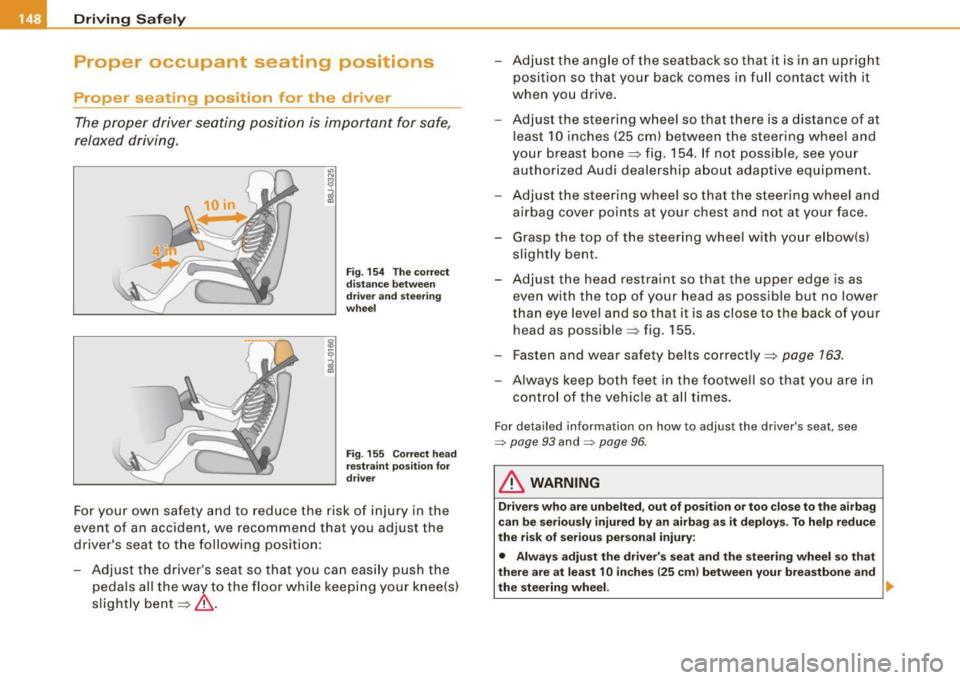
___ D_ r_ i_v _in -= g'- S _ a_f _e _ly.:,._ ______________________________________________ _
Proper occupant seating positi·ons
Proper seating position for the driver
The proper driver seating position is important for safe,
relaxed driving.
Fig. 154 The correct
distance between
driver and steering
wheel
Fig . 155 Correct head
restraint position for
driver
For your own safety and to reduce the risk of injury in the
event of an accident, we recommend that you adjust the
driver's seat to the following position:
- Adjust the driver's seat so that you can easily push the
pedals all the way to the floor while keeping your knee(s)
slightly bent=:>& . - Adjust the angle of the seatback so that
it is in an upright
position so that your back comes in full contact with it
when you drive.
- Adjust the steering wheel so that there is a distance of at
least 10 inches (25 cm) between the steering wheel and
your breast bone=:> fig. 154. If not possible, see your
authorized Audi dealership about adaptive equipment.
- Adjust the steering wheel so that the steering wheel and
airbag cover points at your chest and not at your face.
- Grasp the top of the steering wheel with your elbow(s)
slightly bent.
- Adjust the head restraint so that the upper edge is as
even with the top of your head as possible but no lower
than eye level and so that it is as close to the back of your
head as possible =:> fig. 155.
- Fasten and wear safety belts correctly=:>
page 163.
- Always keep both feet in the footwell so that you are in
control of the vehicle at all times.
For detailed information on how to adjust the driver's seat, see
=> page 93 and :::::, page 96 .
& WARNING
Drivers who are unbelted, out of position or too close to the airbag
can be seriously injured by an airbag as it deploys. To help reduce
the risk of serious personal injury:
• Always adjust the driver's seat and the steering wheel so that
there are at least 10 inches
125 cm) between your breastbone and
the steering wheel. ...